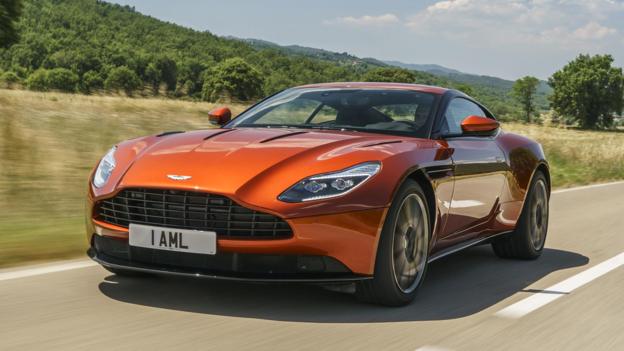
Aston Martin set out to do one thing really well, and with the DB11, it has.
I generally despise first-person car reviews. Particularly when the vehicle in question is expensive, or fast, or both, these stories can quickly devolve into oily billets-doux of the writer’s preternatural giftedness behind the wheel. Or, worse, they become obnoxiously self-deprecating confessionals of their doubtful worthiness in the face of such blinding automotive majesty. So it is with no small amount of consternation that, after stewing over the Aston Martin DB11 for weeks after driving the car, I have decided to approach my take on it from the shameless first-person perspective.

The DB11 costs £154,900 in the UK ($211,995 in the US) and there is nothing sensible about spending that much on a car, and very little point in making sensible comparisons with other such moments of conspicuous consumption — fuel efficiency and cargo capacity and such. For a buyer with the means and the motivation, there is nothing I could possibly write that will dampen enthusiasm for the DB11, short of revealing that it was assembled by gruel-fed orphans in a Dickensian workhouse. And even that, for some, would merely add to its Anglo-mystique.

Candidly, I find it difficult to contain my open admiration for the car, which is poor motoring journalism, at best. I am inordinately fond of it, all of it, and that makes presenting a balanced, consumer-serving review really tough. This is not a vehicle that inspires cross-shopping or Top Trumps-style stats-mashing, except by fantasy-garage types who either can’t afford the car or aren’t old enough to drive it. With deference to James Bond, who for 50-odd years has employed Aston Martins as work vehicles, these are not cars designed to serve any real purpose beyond pleasure. “For the love of beautiful” is a phrase evoked more than once by Aston’s head of design, Marek Reichman, during my time with the DB11 and the Gaydon entourage (in Tuscany, if you must know). It’s a phrase that guided the creation of the car — all of it, not just the exposed bits. And it shows.
I pause now to ask: When did Aston Martins become beautiful? The first DB model, the DB2 of 1950, was lovely, but lovely in a tweedy-jaunty sort of way, rather than a sexy-wow sort of way. Older Aston Martins merit a good many adjectives — words like “pure” (1963 DB5), “masculine” (1972 AMV8) “startling” (1974 Lagonda), and even “preposterous” (2011 Cygnet). But beautiful? Harder to justify. The singular 1960 DB4GT Bertone “Jet” was beautiful, no doubt, but it took an Italian design house and a young designer named Giorgetto Giugiaro to make it so.
We aspire to make the most beautiful cars in the world.
The DB11 is beautiful — straight-up, sexy-wow beautiful. To these first-person eyes it is the most beautiful production car on the planet right now, surpassing in overall comeliness even the candy-sweet Aston Martin Vanquish, which honourably concludes its four-year stint as The Most Beautiful Car on the Planet According to Me. And this is not mere happenstance. Aston Martin has a plan.
Said the company’s chief executive, Andy Palmer: “We aspire to make the most beautiful cars in the world.” Full stop. They put it in the press release, third paragraph. “We aspire to make the most beautiful cars in the world.” He did not say the fastest cars in the world, or the most futuristic cars in the world, or, heaven forbid, the most fuel-efficient cars in the world. He said the most beautiful. And that’s what he is doing. For the love of beautiful.
Much has been made of the differences between the old DB9 and the new DB11. (The DB10, for the uninitiated, was a bespoke concept car created in 2014 as a work vehicle for a certain British secret agent). The structure of the DB11 is 15% stiffer than the DB9’s, for instance, and its engine weighs 10 pounds less. Its wheelbase is 65 millimetres longer and fuel-consumption is down by 20%. It’s all academic, really. This is an entirely new car, created with an entirely new mindset. “Every millimetre of the DB11 has been re-imagined from the ground-up,” said Reichman. A DB9 on hand during the DB11 launch event looked like an orthopaedic loafer next to a Nike Air Max trainer. And the DB9 is a very handsome car. The DB11 is just that much more sexy-wow.
Up front, the clamshell bonnet is a sculptural masterwork — claimed to be the largest single piece of pressed aluminium ever affixed to a car. There are no unsightly shut lines on the upper plane of the bonnet, only fine creases and two pairs of slender, functional vents. Behind the front wheels, the bonnet’s edges meet side strakes that relieve air pressure within the wheel wells to keep the tyres planted at speed.
Moving rearward, the arc of body work that extends from the A- to C-pillars is no mere stamping. Notes Aston: “This incredibly labour-intensive component, which is first extruded, then stretch-bent, then pressed, then laser cut, then polished and finally anodised to achieve the complex shape and flawless finish its design demands.” And this leads the eye to another bit of high-tech frippery. The roof strakes form the edges of intakes at the C-pillars, which channel air through internal ducts and up through slots on the top edge of the boot lid.
This feature has a trademarked name, of course, AeroBlade, and it serves as a ‘virtual spoiler’, creating a wall of high-pressure air that obstructs airflow over the top of the car, reducing lift and allowing the rear wheels to go about their business more effectively. At higher speeds, a small non-virtual spoiler extends upward in front of the slots, allowing wall of air to flair a little higher. Aston Martin insists the AeroBlade works, but it’s a little like the GPS-guided transmission in the Rolls-Royce Wraith. You can’t feel it working, but you can’t feel it notworking, either. No matter: Like so much of the DB11, it will provide owners with some first-rate cocktail conversation.
Speed will be another talking point, of course, and the DB11 is very fast — much more so than the DB9 it replaces. The engine is new: a 5.2-litre V12 with two turbochargers that produces 600 horsepower and 516 pound-feet of torque. Aston claims the car will bolt from zero to 62mph in 3.9 seconds and press on to a top speed of 200mph. The engine is paired with an eight-speed automatic from German transmission-maker ZF Friedrichshafen. It has cool-to-the-touch metal shifter paddles behind the steering wheel for those who crave control, but really, I reckon the transmission is better at the task of gear-selecting than you. Certainly better than me.
Fully kitted, the cabin makes a powerful impression: Swathed in yards and yards of pinked and perforated hide, it’s like sitting in a big Ghillie Brogue. The DB11’s infotainment package is an eon beyond that of its predecessor, thanks to a technology transfusion from Mercedes-Benz (whose parent, Daimler, owns 5% of Aston Martin). The DB9’s Emotion Control Unit, or ECU — a hefty glass “key” that plugged into a slot on the centre console — has been consigned to history, replaced by a somewhat less fanciful start/stop button. My heart goes out to Aston dealers, whose profitability likely hinged on selling replacements for lost ECUs at £900 apiece.
The DB11 leads Aston’s “Second Century” plan, which, says Palmer, calls for the introduction of seven new models over seven years, including a replacement for the Vantage sports car and a proper supercar successor to the Vanquish. There will be a production version of the DBX electric off-roader concept from 2015, as well, though it will have a more traditional SUV profile and a more traditional powerplant. And, of course, there will be the mad AM-RB 001 hypercar, a labour of love for Reichman and the Red Bull Racing F1 team’s chief technical officer, Adrian Newey.
These are heady times for a company that in the early 1980s was struggling to sell three cars per week. And yet, Aston Martin is hardly a cash cow: In June, the 103-year-old company reported a 2015 loss of close to £128m, its fifth straight year of unprofitability. But the DB11 manages to belie its maker’s tough times. The deftness of its design and the soundness of its execution makes Andy Palmer’s big plans for the future seem much easier to believe. If the former Coolest Brand in Britain can the maintain the momentum — across seven cars in seven years — we foresee happy days ahead in Gaydon.
If you would like to comment on this or anything else you have seen on BBC Autos, head over to our Facebook page or message us on Twitter.
And if you liked this story, sign up for the weekly bbc.com features newsletter, called “If You Only Read 6 Things This Week”. A handpicked selection of stories from BBC Autos, Future, Earth, Culture, Capital and Travel, delivered to your inbox every Friday.
